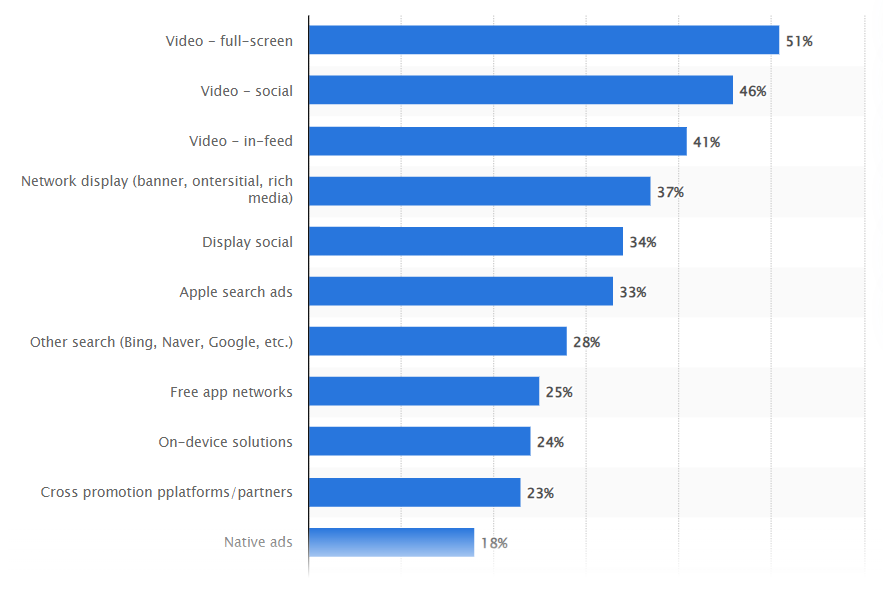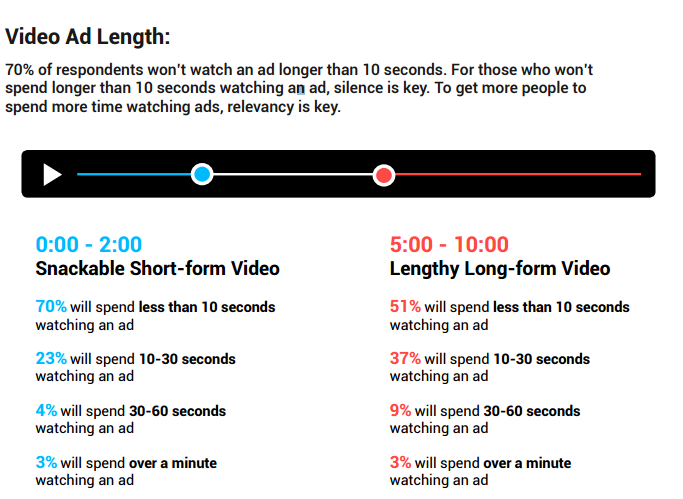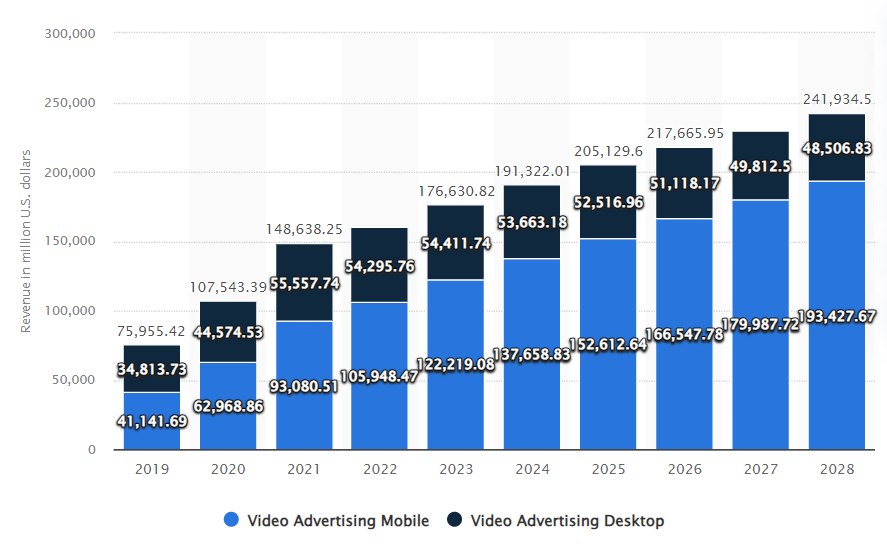Video ads reign the world of digital advertising!
Despite the complexity and investment cost, the spending on video ads surges yearly. The reason is simple: no other ad format can beat video ads in engagement and interactions.
In this blog, you’ll learn the best practices to improve video ad performance and how to make the most out of them.
Table of Contents
What Is Video Advertising?
Video advertising refers to using video as a format to serve engaging ads that deliver a short brand message to the audience. It is the most preferable form of advertising and performs better than other ad formats like banner ads, native ads, etc.
Publishers can create video ad spaces on their websites and sell them to advertisers through various programmatic means or direct deals.
The video ads can be placed in different mediums, which include:
- Webpage (Desktop and mobile)
- Social Media (Facebook, Instagram, LinkedIn, Twitter, etc.)
- Video platform (YouTube and Dailymotion)
- Over-the-top advertising (OTT) (Netflix, Hulu, and Amazon)
- Connected TV (CTV)
Overall, publishers earn from selling ad spaces to advertisers and getting views, clicks, and conversions on ads. The advertisers generate high ROI with leads, conversions, and sales from these video ads.
Mindblowing Facts of Digital Video Ads
There are many reasons why video ad is a high-performing format in digital advertising. Here are a few reasons why:
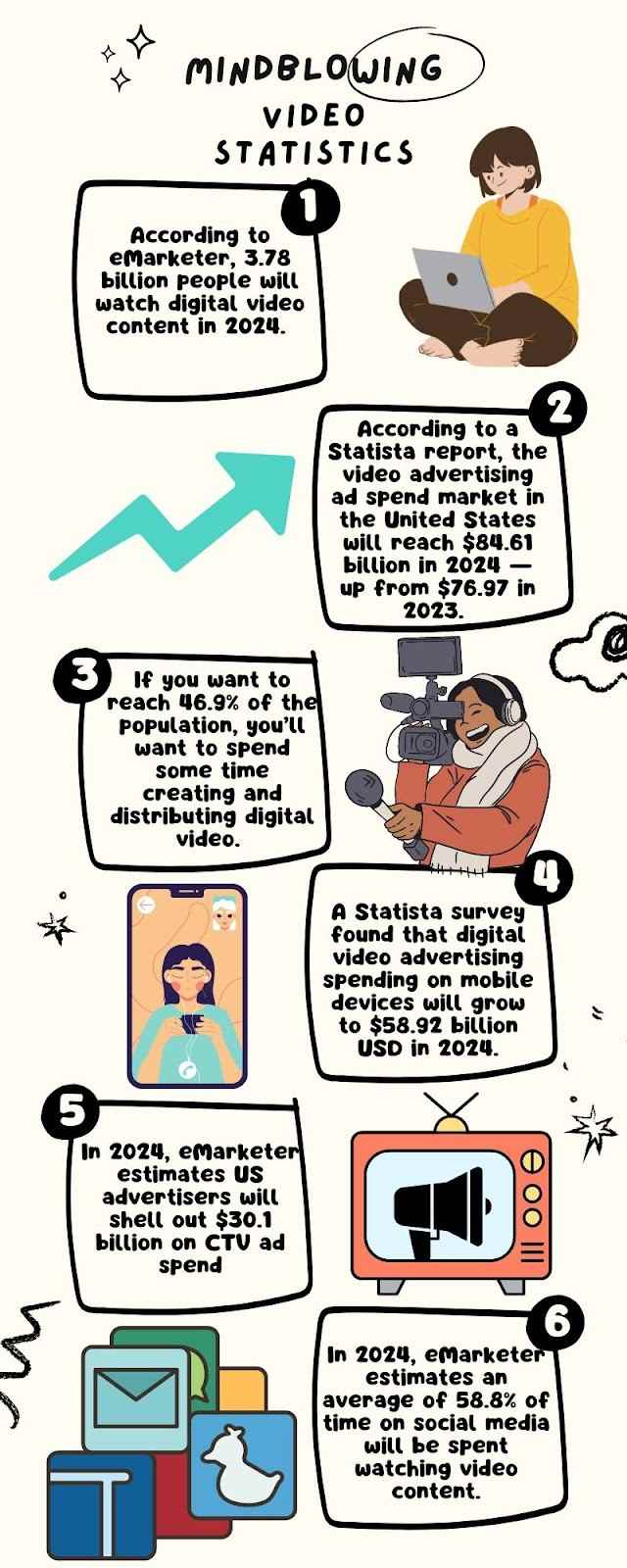
Source: emarketer and Statista
6 Reasons Why Video Ads Are the Future of Advertising?
Video ads dominate other formats
Video ads are better than other formats because users prefer watching videos over reading text. Due to the internet’s easy accessibility:
- 85% of U.S. internet users watch video content monthly on their devices.
- 9 out of 10 people prefer to watch video content on YouTube.
- On average, U.S. adults spend 62 minutes per day watching digital videos.
Videos attract users and are easy to understand and remember. That is why video ads are a potential means for marketers to reach the right customers.

Hubspot’s research says that 54% of people prefer to see videos from brands or businesses compared to other content formats. By ads, video performs better than display and native ad formats. Video ads fill the top three spots, followed by display and search ads, as you can see in this screenshot:
Video ads are highly accessible with mobile dominance
Over 55% of the website traffic comes from mobile, and 92% of internet users use mobile devices to access sites.
With mobile dominance, video ads are the best way to reach users, as they are easily accessible. However, to achieve the best results, you need to improve the responsiveness of video ads across devices.
This accessibility will multiply if the video goes viral and is shared by users on a larger scale. Video ads on mobile are easier to share than on desktop. The videos on social networks were shared 12 times more than images and text. Also, some other research says nearly 700 videos are shared every minute by Twitter users.
Video ads are catchy, concise, and relatable. It can convey a short brand message quickly. That is why people find it worth distributing. Therefore, it creates interaction and engagement on a larger scale than image ads.
Video ads increase engagement
Video ads catch users’ attention with motion and sound, which leads to high engagement and interaction. These ads will bring you a good amount of viewable impressions and clicks, improving value of your ad inventory.
This ad format is mostly preferred for its narrative characteristics. It allows you to connect with users through personalized ads.
According to Meta data, a video ad delivers them a high return on ad spend (ROAS). Specifically, a short video of 15 seconds works better for their promotions.
Video ads placed at the ideal location, followed by a perfect call to action, bring higher engagement and conversions. Video ads can be interruptive when they are auto-played with the sound on, and so the engagement rate greatly varies depending on it.
According to the study, 45% of people prefer muted ads. Even targeted ads come next to it in tolerable list ads.
Video length also matters in driving engagement. The same study says the below 10 seconds is the ideal range to keep users engaged. Relevance can play a big role in keeping users engaged for more than 10 seconds.
Even though the video ads are highly engaging, the engagement varies depending on how you show it to your website users. Using relevant, muted, auto-play video ads is the best practice.
Video ads have high targeting capabilities
Video ads that are personalized based on user demographics, interests, and behavior reap better results. As a publisher, you can personalize video ads with first-party data, behavioral targeting, and contextual targeting to improve engagement and conversions.
Users are 35% more likely to watch personalized ads than non-personalized ones. 93% of the companies say they get high conversions from personalized ads.
Video ads drive conversions and sales
Video ads are much better options for knowing about the product than images. It influences and encourages users to buy the product. Therefore, it increases the conversion rate and sales.
According to Wyzowal, audiences are 17% more likely to buy the product after watching video ads than static ads. 45% said they would buy a product discovered through video ads.
Another recent study says 87% of marketers increased their sales with videos, which include video ads. 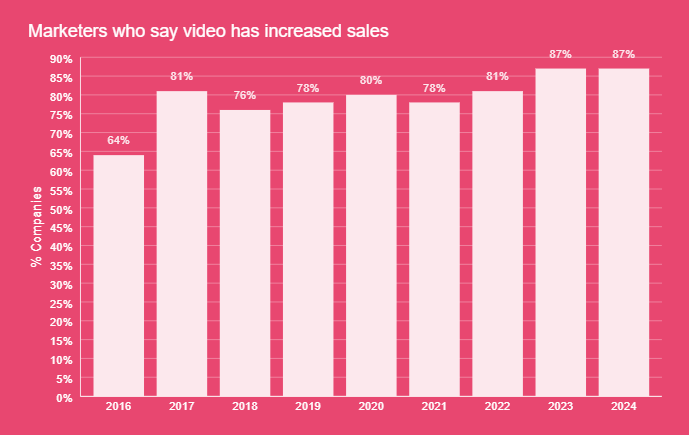 Source
Source
Hence, video ads help you achieve higher Click-through rates (CTR), Cost-per-acquisition (CPA), conversions, and leads, increasing the value of your ad inventory.
Video ads generate high ROI
Obviously, higher engagement, interaction, conversion, and sales of video ads lead to high ROI for both publishers and advertisers.
According to Statista, the video ad revenue worldwide in 2023 is $176.63 billion in both desktop and mobile. It is predicted to reach $241.93 billion in 2028.
Also, 92% of marketers, according to Wyzowal, said that video ads give them high ROI.
Overall, these statistics show massive increase in video spend and performance. And there is no sign of slowing down of video ads now or in the future.
Best Practices on Video Ads for Publishers
As discussed in depth above, video ads can be the most effective ad formats. However, their effectiveness depends on how you use them and present them to users. We have covered a few best practices to help you drive conversions:
- Find the best ad placement: Increasing ad viewability from 50 to 80% uplifts the revenue by 80%. Therefore, work on finding the best ad placement and size for video ads to improve your viewability rate.
- Filter out low-quality ads: Focus on allowing or filtering only high-quality videos from advertisers. The first ten seconds of the video determines how long the video will engage the users. Quality is another important factor determining the user’s decision to see the video or purchase the product. Brand safety checking is crucial to maintaining good user experience, traffic, and customer retention.
- Choose the best video player partner: with high-end configuration and navigational options for users. It should support various video tags like VAST and VPAID. Many third-party providers can help you with video player implementation with essential specifications.
- Video ad format that aligns with your needs: There are different types of video ads, so choose the one that aligns best with user interest. Choose instream video ad formats on video platforms, and sticky video ads are better on content websites.
- A/B testing is the way to go: Test and optimize different formats and sizes to end up in highly performing combinations. It will reflect positively on impressions, conversions, and ad revenue.
Trends in Video Advertising
It is important to know recent trends to put video ads where they matter. We have covered a few that are performing well lately in the digital marketing landscape.
Connected TV (CTV) ads
Connected TV refers to devices connected to the internet that allow individuals to stream music and videos.
The adoption of connected TV is high, with 109 million U.S. households. This paved the way for increasing CTV ads, mainly CTV video ads.
This CTV ad spend is $26.92 billion in 2023, a 27% increase from the previous year. Research shows that C
TV ads perform better than linear ads in engagement and conversions. Many marketers see these ads as more effective in performance and collecting data that can be used for targeting.
Micro video ads
The trend of micro video ads is surging everywhere. This is due to their capacity to attract viewers’ attention quickly and leave lasting impressions.
TikTok, Instagram reels, and YouTube shorts are the best examples of streaming micro video ads. These are also native video ads that can be inserted between the reels, hoping that users will see them in their daily scroll. Micro video ads engage viewers with everlasting impact, which is why marketers greatly embrace them.
Video ads in social media
Social media networks are undeniably the best place to put video ads and reap better outcomes.
Many social media apps let marketers create, store, and upload ads. The most popular are Facebook, LinkedIn, and Instagram. More than any platform or website, social media has abundant user data like demographics and interests. This is why social media has been a popular and trending place to put video ads for a while now.
Video Ads Eternity Continues
Video has become a part of everyday life since internet accessibility has risen.
Eventually, it paved a golden way for marketers to captivate audiences with video ads. It stands out from the rest of the marketing mediums and gives better promotion results.
Relevancy and personalization add icing to it.
Therefore, it would be better to start utilizing video ads now if you were not in the past.
Video ads stand across time, and it is worth trying regardless of the high investment cost. It drives you up the growth ladder fast to increase your ad space value and gets high ROI.



